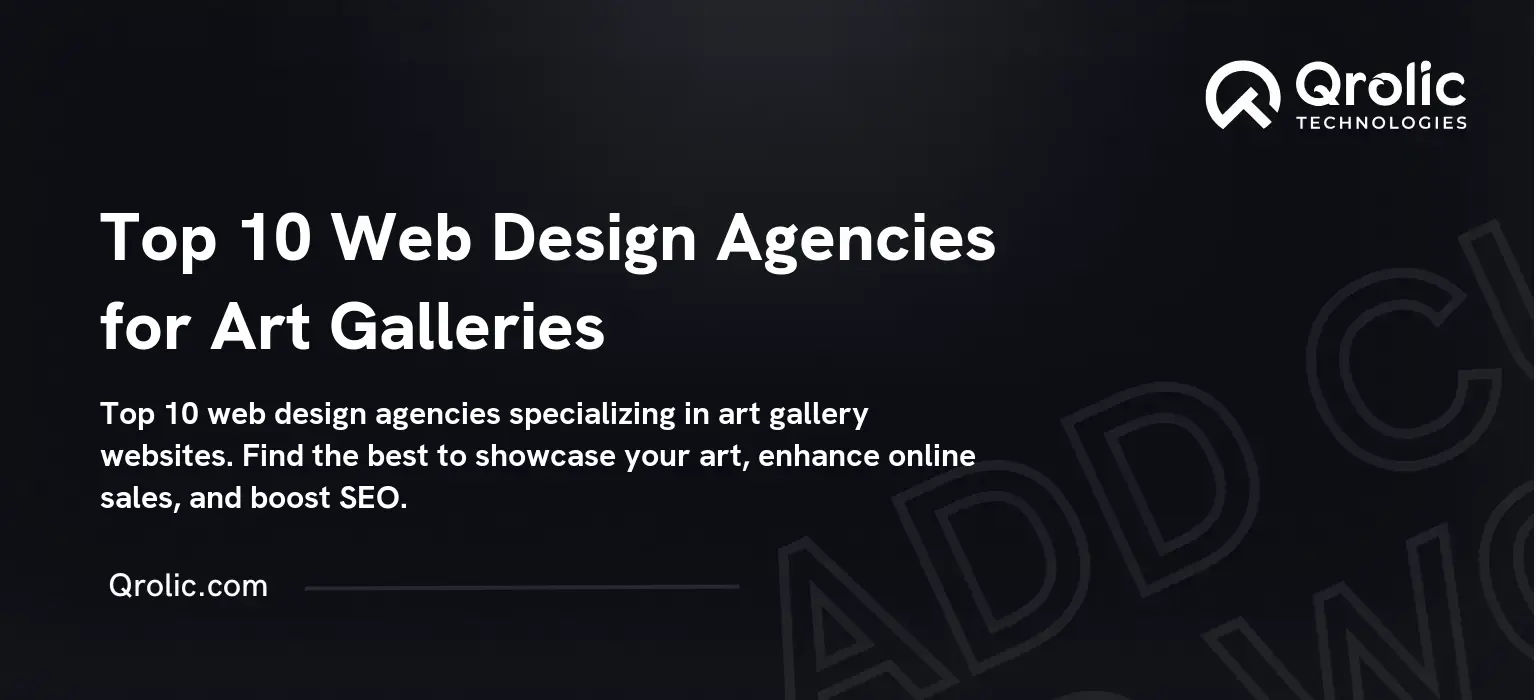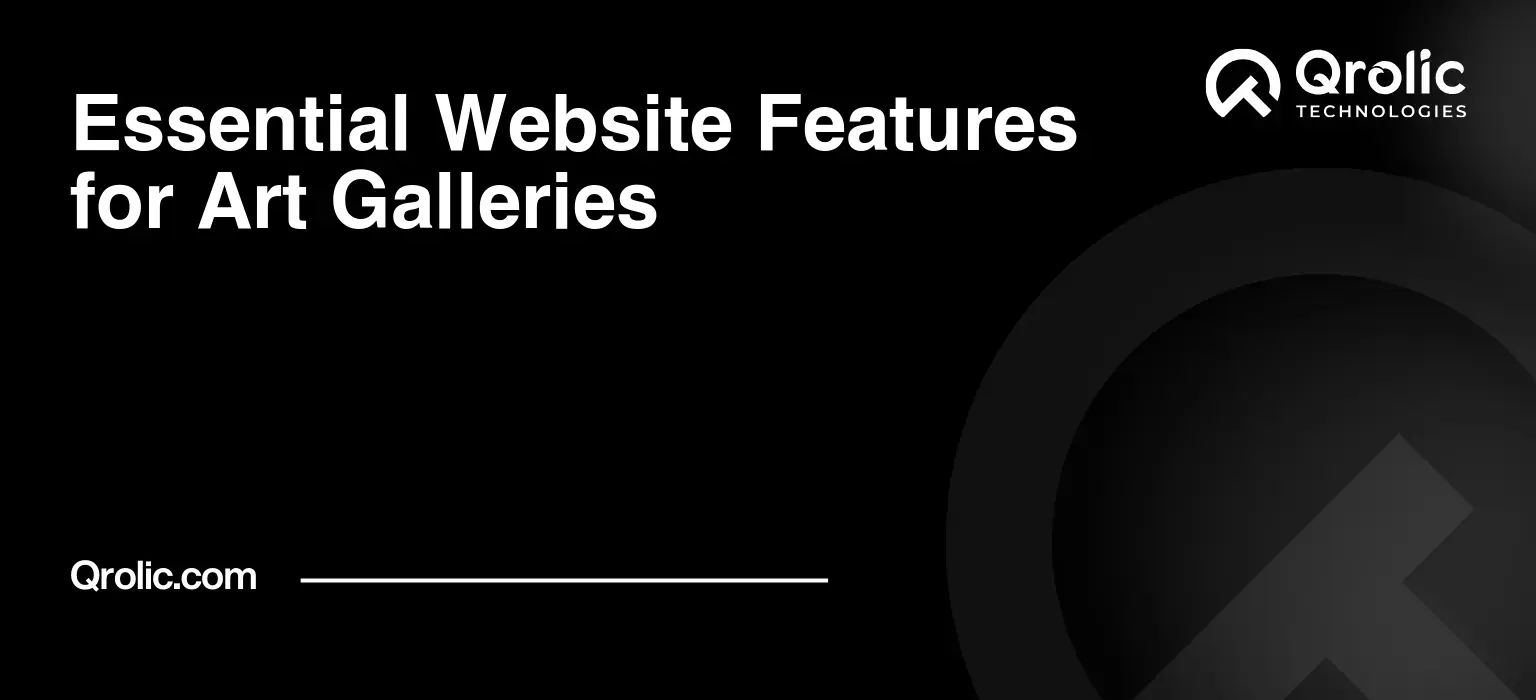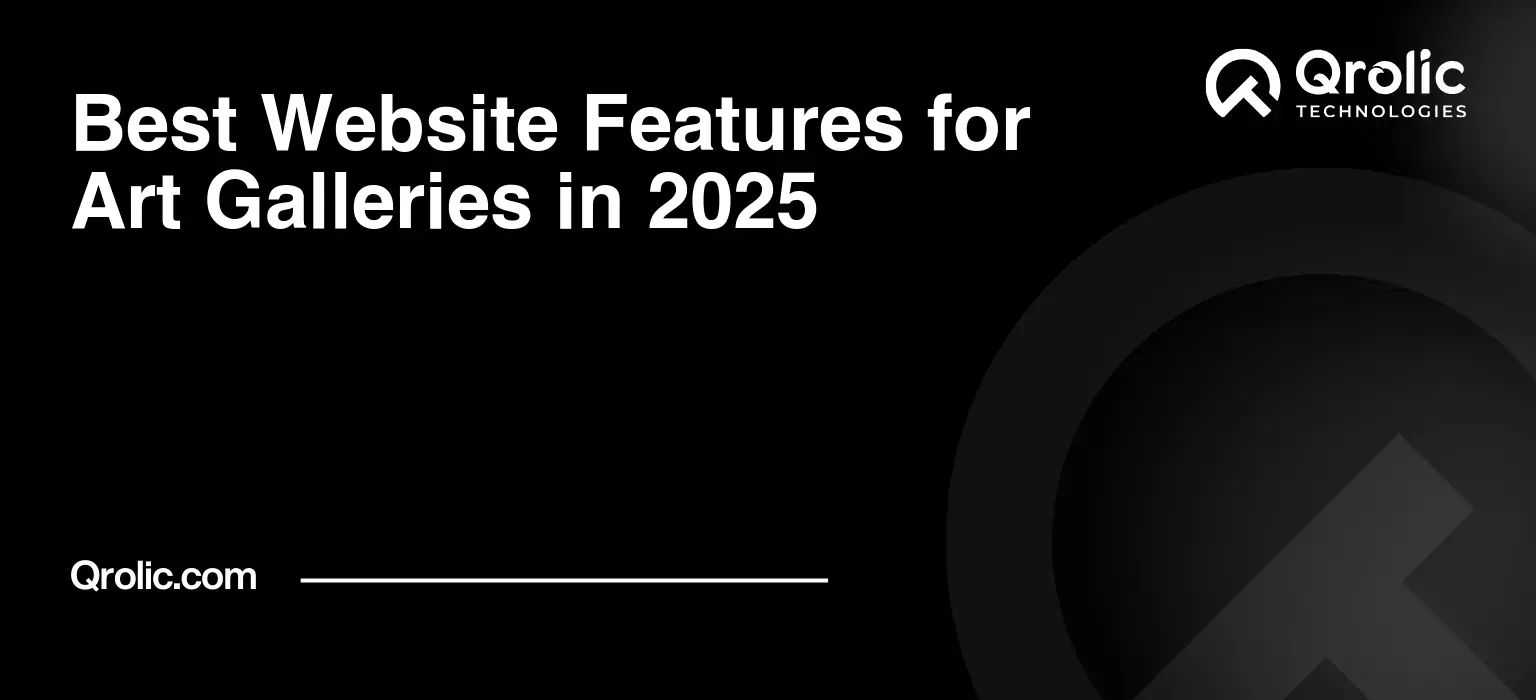Quick Summary:
- Specialized agencies are vital for unique art gallery web design.
- Look for stunning visuals, easy navigation, and e-commerce features.
- Define your goals, budget, and review agency portfolios carefully.
- Qrolic Technologies offers custom, SEO-friendly gallery websites.
Table of Contents
- Top 10 Web Design Agencies for Art Galleries
- The Need for Specialized Art Gallery Web Design
- Key Features of Exceptional Art Gallery Websites
- Top 10 Web Design Agencies for Art Galleries
- Choosing the Right Agency: A Step-by-Step Guide
- The Importance of SEO for Art Gallery Websites
- Qrolic Technologies: Your Partner in Art Gallery Web Design
- Conclusion
Top 10 Web Design Agencies for Art Galleries
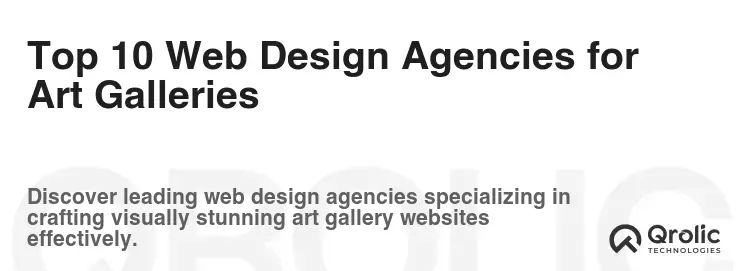
The digital realm has become an indispensable space for art galleries, transforming how they connect with audiences, showcase artists, and conduct business. A compelling website isn’t just an online brochure; it’s a vital extension of the gallery’s physical space, a 24/7 exhibition, and a powerful marketing tool. But creating a website that truly reflects the sophistication and nuance of the art world requires specialized expertise. That’s where art gallery web design agencies come in. These agencies understand the unique needs of the art industry and possess the skills to craft digital experiences that captivate and engage.
This article delves into the world of specialized web design agencies, presenting the top 10 contenders that excel in creating exceptional websites for art galleries. We’ll explore what makes them stand out, the key features to look for, and the benefits of partnering with a specialist. Whether you’re a seasoned gallery owner or just starting out, understanding the landscape of art gallery web design is crucial for your success.
The Need for Specialized Art Gallery Web Design
Why can’t any web design agency handle an art gallery website? The truth is, they can build a functional website, but to build one that resonates with the art world requires a different approach. Here’s why specialized art industry web designers are essential:
- Understanding the Aesthetic: Art isn’t just about images; it’s about the feel, the emotion, and the story behind each piece. Art industry web designers understand the importance of visual hierarchy, typography, and white space in presenting art in its best light. They don’t just build a website; they curate an online experience.
- Navigating Complex Content: Art galleries often deal with complex information – artist bios, exhibitions, collections, pricing (where appropriate), and detailed artwork descriptions. Specialised Web Development for exhibitions involves organizing this content intuitively, ensuring it’s easily navigable and searchable for users.
- High-Quality Image Handling: The visual quality of images on a gallery website is paramount. Specialist agencies have the expertise to optimize high-resolution images for web use without compromising quality, ensuring swift load times. They also understand the need for responsive design, making sure images look great across all devices.
- Integrating E-commerce Functionality: For galleries that sell art online, integrating secure and seamless e-commerce features is vital. Art industry web designers can incorporate features like secure payment gateways, inventory management systems, and shipping options, all within the elegant design of the site.
- Showcasing Exhibitions Effectively: A critical component of any art gallery website is the ability to highlight current and past exhibitions. Specialised agencies know how to create dedicated exhibition pages that showcase the event with stunning images, detailed descriptions, and visitor information. These pages must be visually compelling and provide comprehensive details.
- Reflecting the Gallery’s Brand: Every art gallery has a unique identity and a brand story. A specialised agency will work closely with you to create a website that truly reflects your gallery’s brand, ensuring consistency across your online and offline presence. They understand the nuances of luxury branding, ensuring that website design enhance its high standards.
- SEO for the Art World: Getting your website seen by the right audience is crucial. Specialized agencies employ specific SEO strategies that use art-related keywords to attract art lovers, collectors, and potential clients. They know how to optimise a site for search engines, enhancing its visibility in the art world.
- Security and Reliability: Dealing with valuable artworks and potentially sensitive data requires high-level security. Specialised agencies build websites with robust security protocols, protecting your gallery’s information and your clients’ data.
- Accessibility: Websites must be accessible to all users, and specialised agencies understand this need. They design sites with accessibility features that ensure all users can navigate the site effortlessly.
- Ongoing Maintenance and Support: Launching a website is just the start. Specialist agencies provide ongoing maintenance and support to ensure the website remains secure, up-to-date, and optimized for performance. They understand the ongoing updates that a gallery site require due to regular changing artworks and exhibitions.
Key Features of Exceptional Art Gallery Websites
Before we dive into our top 10 agencies, let’s examine the key features that every excellent art gallery website should possess:
- Stunning Visual Presentation: High-quality images, videos, and virtual tours are a must. The website should make art the hero.
- Clean and Intuitive Navigation: Users should find it easy to browse artists, exhibitions, and specific artworks. Information should be readily accessible.
- Detailed Artwork Pages: Each artwork should have its own dedicated page with high-resolution images, detailed descriptions, artist bios, provenance (if available), and pricing (where applicable).
- Exhibition Pages: Dedicated pages for current and past exhibitions with relevant details such as dates, featured artists, and exhibition statements.
- Artist Profiles: Comprehensive profiles of artists, including their bios, artist statements, and a gallery of their available artworks.
- E-commerce Functionality: The ability to purchase art online through secure payment gateways, along with options for shipping, returns, and secure transactions.
- Contact and Location Information: Clear and accessible contact information, directions, and opening hours.
- Blog or News Section: Sharing news about upcoming events, new artists, and industry trends keeps visitors engaged and improves SEO.
- Responsive Design: Ensures the website looks fantastic and functions flawlessly on any device—desktop, tablet, and mobile.
- Fast Loading Speeds: Optimised images and site structure are vital to avoid slow loading times, which can cause visitors to leave.
- Search Functionality: A robust search feature that allows users to easily find artworks, artists, or exhibitions they’re looking for.
- Social Media Integration: Easy sharing options for artworks and exhibitions to social platforms.
- Membership and Mailing List Functionality: Options for users to sign up for a mailing list and for galleries to manage memberships.
- Virtual Tours: Immersive 3D tours or interactive walkthroughs of the gallery for those who cannot visit in person.
- Multilingual Support: If your gallery serves a global audience, multilingual support is essential.
- Accessibility Compliance: A website should be accessible to all users, regardless of their abilities.
Top 10 Web Design Agencies for Art Galleries
Now, let’s explore the top 10 web design agencies that have demonstrated expertise in creating exceptional websites for art galleries:
- Artlogic: A global leader in art industry web design, Artlogic specialises exclusively in creating websites for galleries, artists, and art organisations. They offer a comprehensive platform with integrated e-commerce, CRM, and exhibition management tools. Known for their sleek designs and robust features, Artlogic is the go-to choice for many established galleries. Their expertise in art-specific databases and inventory systems is unparalleled.
- Key Strengths: Specialised art platform, integrated CRM and e-commerce, advanced inventory management.
- Ideal For: Established galleries and organisations requiring an all-in-one solution.
- ArtSites: Specialising exclusively in web design for artists and galleries, ArtSites has a vast understanding of the needs of the art market. They offer a user-friendly content management system (CMS), excellent image handling, and responsive design. ArtSites is known for creating bespoke designs that are both aesthetically pleasing and highly functional. Their focus on the user experience is evident in the clarity and ease of use of the websites they create.
- Key Strengths: User-friendly CMS, bespoke designs, responsive across all devices, excellent image handling.
- Ideal For: Galleries looking for a custom-designed website with ease of use.
- White Wall: Based in the UK, White Wall boasts years of experience working within the art sector. Their expertise extends to creating websites for museums, art fairs, and cultural organisations. They are known for clean, sophisticated designs with an emphasis on user experience, delivering websites that are intuitive and easy to navigate.
- Key Strengths: Clean designs, strong focus on user experience, experience with museum and art fair websites.
- Ideal For: Art galleries seeking a user-centric, sophisticated design.
- ArtWeb: ArtWeb is a very popular choice for many artists as they provide a cost-effective solution for creating a professional online presence. They offer several subscription tiers which suit both new and established artists and galleries alike. ArtWeb also includes tools which will help your website rank higher in search engines which is highly beneficial for getting your gallery seen.
- Key Strengths: Cost-effective, intuitive CMS, built in SEO tools.
- Ideal For: New and established galleries seeking an affordable and efficient website creation platform
- Qrolic Technologies: Qrolic Technologies understands the nuances of creating visually captivating websites that are also highly functional. Although not exclusively focused on the art industry, their expertise in creating responsive, e-commerce-enabled websites, along with a strong focus on user experience, makes them a strong contender for art galleries. Their ability to customise solutions to meet specific client needs and budgets makes them a versatile choice. They use advanced SEO strategies to help client sites to rank higher in search engine results. They also have strong design understanding and can really work with the creative side of your business to help it stand out.
- Key Strengths: Responsive designs, customisable solutions, e-commerce expertise, strong user experience focus, SEO expert.
- Ideal For: Art galleries looking for a custom-tailored website with a focus on functionality and SEO.
- D&K Creative: This is an American agency that has an extensive understanding of the importance of visual presentation for art galleries. The agency has worked with both established and up and coming galleries with a vast range of styles. They also offer a range of other design services to help you with marketing collateral.
- Key Strengths: Great visual understanding, experience with various art styles.
- Ideal For: Galleries that want a complete and integrated design approach.
- Media Genesis: With a portfolio including websites for leading galleries and cultural institutions, Media Genesis is known for their visually impactful designs and focus on user engagement. They have a full understanding of the importance of the visual for art galleries, with a portfolio which showcases their diverse range of aesthetics. They also incorporate a range of other marketing support.
- Key Strengths: Stunning design, user engagement, marketing support.
- Ideal For: Galleries seeking to make a powerful online impact.
- Kreative Fuel: Kreative Fuel excels in building engaging experiences that are visually stunning and highly functional. They are known for creating websites that enhance online sales and are proficient in developing e-commerce platforms for art galleries. They understand the importance of visual storytelling and ensure that websites resonate with a gallery’s aesthetic vision. They are also adept at using SEO to help clients rank higher online.
- Key Strengths: E-commerce expertise, visual storytelling, strong SEO practice.
- Ideal For: Galleries focused on driving online sales and enhancing their digital presence.
- Made to Engage: This agency offers custom web designs tailored to specific art gallery needs. They will work with you closely to establish a bespoke web design that meets the branding and requirements of your gallery. They also offer social media marketing and content creation.
- Key Strengths: Custom designs, bespoke service, marketing services.
- Ideal For: Galleries that require bespoke web design.
- Studio V Design: Studio V Design is known for creating a bespoke experience for their clients. Their websites are renowned for being highly visually compelling while also providing excellent functionality for clients to be able to manage their sites. They are experienced with creating custom database solutions, which can be beneficial for managing inventory.
- Key Strengths: Bespoke web design, excellent client support, custom database solutions.
- Ideal For: Galleries that need a highly specialised website solution.
Choosing the Right Agency: A Step-by-Step Guide
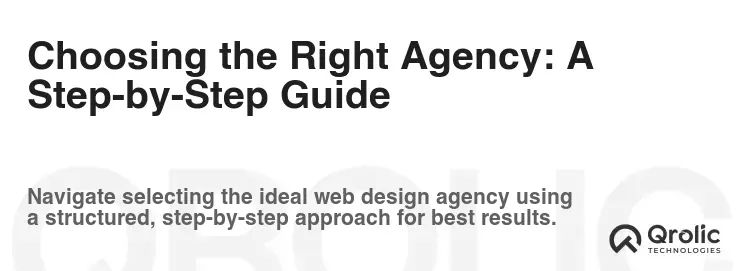
Selecting the right art gallery web design agency is a crucial decision that will significantly impact your online success. Here’s a step-by-step guide to help you navigate the process:
- Define Your Goals: Start by clarifying your objectives. What do you want your website to achieve? Are you looking to primarily showcase art, sell online, build an email list, or generate leads? Understanding your goals will help you identify the agencies that are best equipped to meet your needs.
- Establish Your Budget: Set a realistic budget for your website project. This will help you narrow down your options and find agencies that fit within your financial constraints. Remember to consider not just the initial build, but also ongoing maintenance costs.
- Review Portfolios: Carefully examine the portfolios of potential agencies. Look for websites that resonate with your gallery’s aesthetic and functionality requirements. Pay close attention to their experience in the art sector, if relevant.
- Consider Technology and Functionality: Evaluate the agencies’ technological capabilities, including their CMS expertise, e-commerce solutions, and their ability to create responsive and fast-loading websites.
- Assess Communication and Process: Evaluate the agencies’ communication style and their development process. It is essential to work with a team that is transparent, responsive, and willing to collaborate closely with you.
- Check References: Ask for references and speak to past clients to gain insights into their experiences with each agency. This will help you get a deeper understanding of their work ethics and customer service.
- Discuss Ongoing Support: Discuss the agency’s plans for ongoing maintenance, security, and support. A website needs continuous updates and maintenance, so make sure the agency offers reliable support.
- Request a Proposal: Once you’ve narrowed down your options, request detailed proposals from each agency, including timelines, costs, and deliverables.
- Make a Decision: Evaluate the proposals and choose the agency that you believe will be the best fit for your gallery. Consider all aspects of your experience with the agency so far, and think about who you feel you can trust the most.
The Importance of SEO for Art Gallery Websites
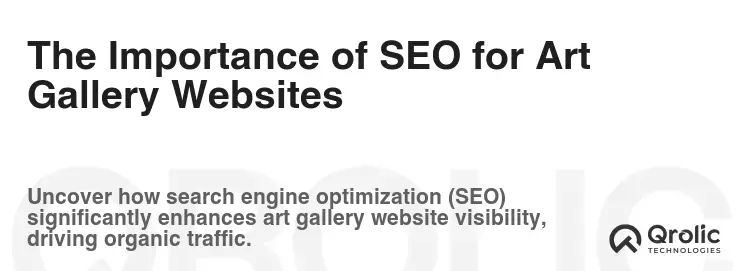
Search Engine Optimisation (SEO) is vital for art gallery websites. It increases visibility in search engines like Google, ensuring that potential visitors and buyers can find your gallery online. A well-optimised website attracts organic traffic, reduces your reliance on paid advertising, and builds long-term online success. This involves:
- Keyword Research: Identifying the keywords and phrases that people use to find art galleries, artists, and exhibitions.
- On-Page Optimisation: Optimising your website content, including page titles, descriptions, headings, and image alt tags with relevant keywords.
- Off-Page Optimisation: Building high-quality backlinks from other reputable websites in the art industry.
- Technical SEO: Ensuring that your website is technically sound, fast-loading, mobile-friendly, and easily crawlable by search engines.
- Local SEO: Optimising your website for local searches, which is crucial for art galleries with physical locations.
- Content Marketing: Creating informative and engaging blog posts and articles about art trends, artists, and exhibitions.
Qrolic Technologies: Your Partner in Art Gallery Web Design
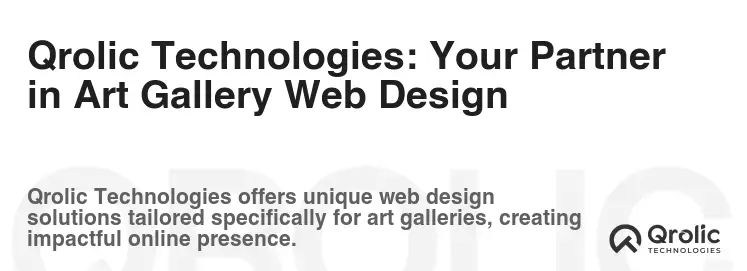
While Qrolic Technologies isn’t exclusively focused on the art world, their broad skill set and adaptable approach makes them a strong choice for art galleries seeking a professional and functional online platform. Qrolic’s understanding of user experience, responsive design, and e-commerce functionality translates seamlessly to the art industry. Here’s why Qrolic stands out:
- Customisable Designs: Qrolic excels in creating unique, bespoke website designs that align with a gallery’s specific brand and aesthetic. They understand that every art gallery is different and needs a tailored approach.
- E-commerce Expertise: They can build secure, feature-rich e-commerce platforms that allow art galleries to sell their artworks online seamlessly. This includes secure payment gateway integration, inventory management, and shipping options.
- Strong SEO Practices: Qrolic implements effective SEO strategies, incorporating art-related keywords to ensure that art gallery websites rank highly in search results. This drives organic traffic and attracts potential customers.
- User-Friendly Design: Their focus on user experience ensures that websites are intuitive, easy to navigate, and engaging for visitors.
- Responsive Development: Websites developed by Qrolic are responsive, functioning perfectly on all devices, which ensures a great experience for all users.
- Ongoing Support: Qrolic provides ongoing support and maintenance to ensure your website remains secure, up-to-date, and performs optimally.
- Collaborative Approach: Qrolic works closely with their clients, ensuring that their vision is brought to life and that the design process is seamless and collaborative.
Conclusion
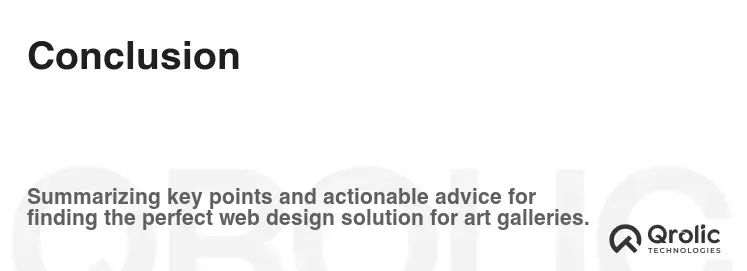
The right website can transform an art gallery’s reach, impact, and success. Choosing a specialist agency to develop your website can bring a host of benefits, from ensuring that your gallery is presented in a visually pleasing way to ensuring that the user experience is smooth and easy. Whether you opt for a niche agency like Artlogic or Artsites or a versatile partner like Qrolic Technologies, make sure the agency has the experience, creativity, and technical expertise to bring your vision to life. By carefully evaluating your options and working with the right agency, you can create a website that not only showcases your art beautifully but also drives engagement and success. Remember that a website is not just a digital brochure; it’s a dynamic tool that requires ongoing attention and optimization. By partnering with the right agency, you can ensure that your gallery thrives in the digital age and connects with art lovers worldwide.
